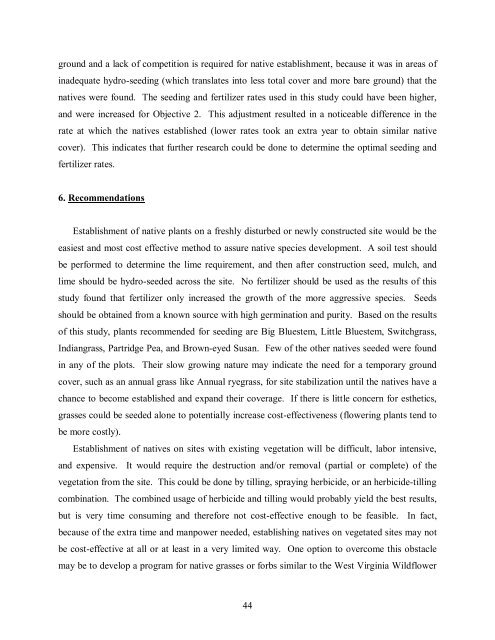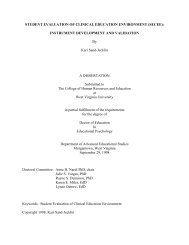The Use of Native Plants for Revegetation along West Virginia ...
The Use of Native Plants for Revegetation along West Virginia ...
The Use of Native Plants for Revegetation along West Virginia ...
Create successful ePaper yourself
Turn your PDF publications into a flip-book with our unique Google optimized e-Paper software.
ground and a lack <strong>of</strong> competition is required <strong>for</strong> native establishment, because it was in areas <strong>of</strong><br />
inadequate hydro-seeding (which translates into less total cover and more bare ground) that the<br />
natives were found. <strong>The</strong> seeding and fertilizer rates used in this study could have been higher,<br />
and were increased <strong>for</strong> Objective 2. This adjustment resulted in a noticeable difference in the<br />
rate at which the natives established (lower rates took an extra year to obtain similar native<br />
cover). This indicates that further research could be done to determine the optimal seeding and<br />
fertilizer rates.<br />
6. Recommendations<br />
Establishment <strong>of</strong> native plants on a freshly disturbed or newly constructed site would be the<br />
easiest and most cost effective method to assure native species development. A soil test should<br />
be per<strong>for</strong>med to determine the lime requirement, and then after construction seed, mulch, and<br />
lime should be hydro-seeded across the site. No fertilizer should be used as the results <strong>of</strong> this<br />
study found that fertilizer only increased the growth <strong>of</strong> the more aggressive species. Seeds<br />
should be obtained from a known source with high germination and purity. Based on the results<br />
<strong>of</strong> this study, plants recommended <strong>for</strong> seeding are Big Bluestem, Little Bluestem, Switchgrass,<br />
Indiangrass, Partridge Pea, and Brown-eyed Susan. Few <strong>of</strong> the other natives seeded were found<br />
in any <strong>of</strong> the plots. <strong>The</strong>ir slow growing nature may indicate the need <strong>for</strong> a temporary ground<br />
cover, such as an annual grass like Annual ryegrass, <strong>for</strong> site stabilization until the natives have a<br />
chance to become established and expand their coverage. If there is little concern <strong>for</strong> esthetics,<br />
grasses could be seeded alone to potentially increase cost-effectiveness (flowering plants tend to<br />
be more costly).<br />
Establishment <strong>of</strong> natives on sites with existing vegetation will be difficult, labor intensive,<br />
and expensive. It would require the destruction and/or removal (partial or complete) <strong>of</strong> the<br />
vegetation from the site. This could be done by tilling, spraying herbicide, or an herbicide-tilling<br />
combination. <strong>The</strong> combined usage <strong>of</strong> herbicide and tilling would probably yield the best results,<br />
but is very time consuming and there<strong>for</strong>e not cost-effective enough to be feasible. In fact,<br />
because <strong>of</strong> the extra time and manpower needed, establishing natives on vegetated sites may not<br />
be cost-effective at all or at least in a very limited way. One option to overcome this obstacle<br />
may be to develop a program <strong>for</strong> native grasses or <strong>for</strong>bs similar to the <strong>West</strong> <strong>Virginia</strong> Wildflower<br />
44












